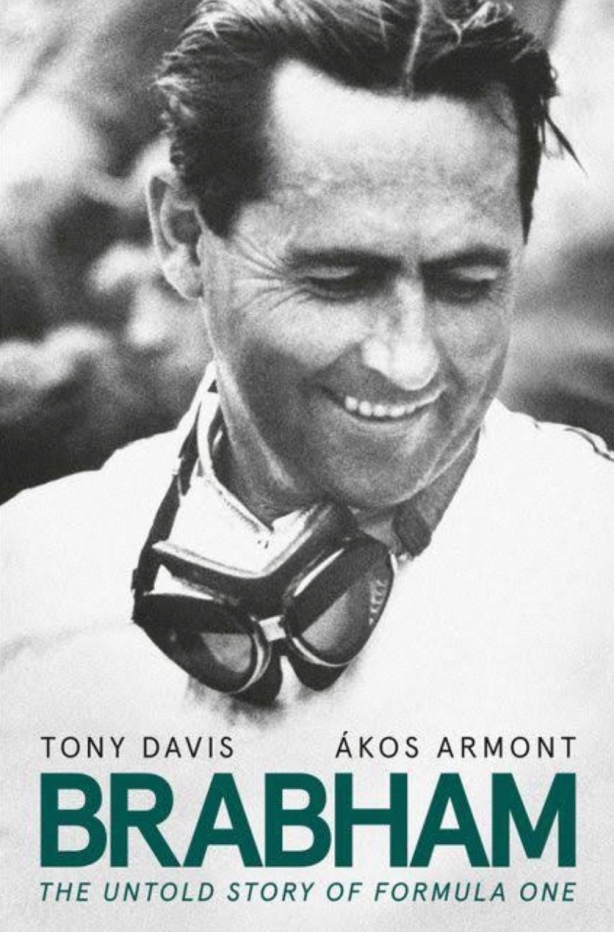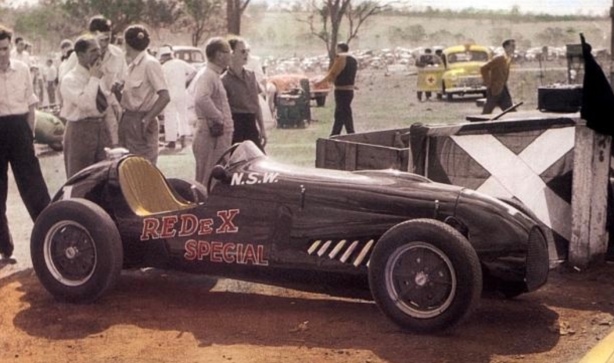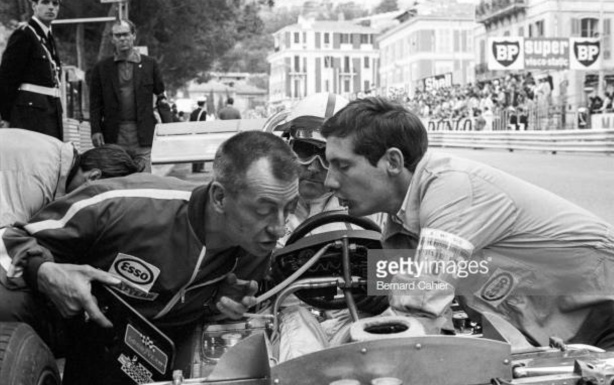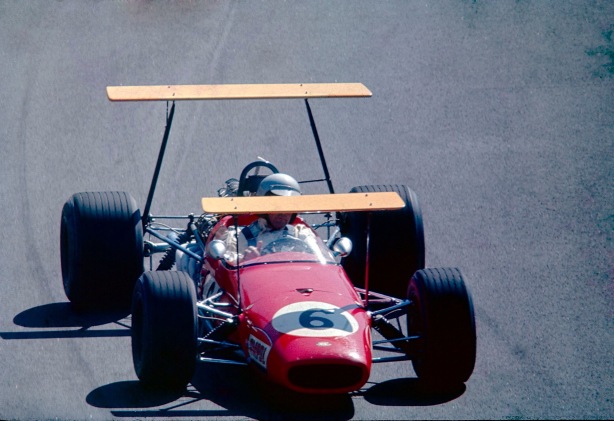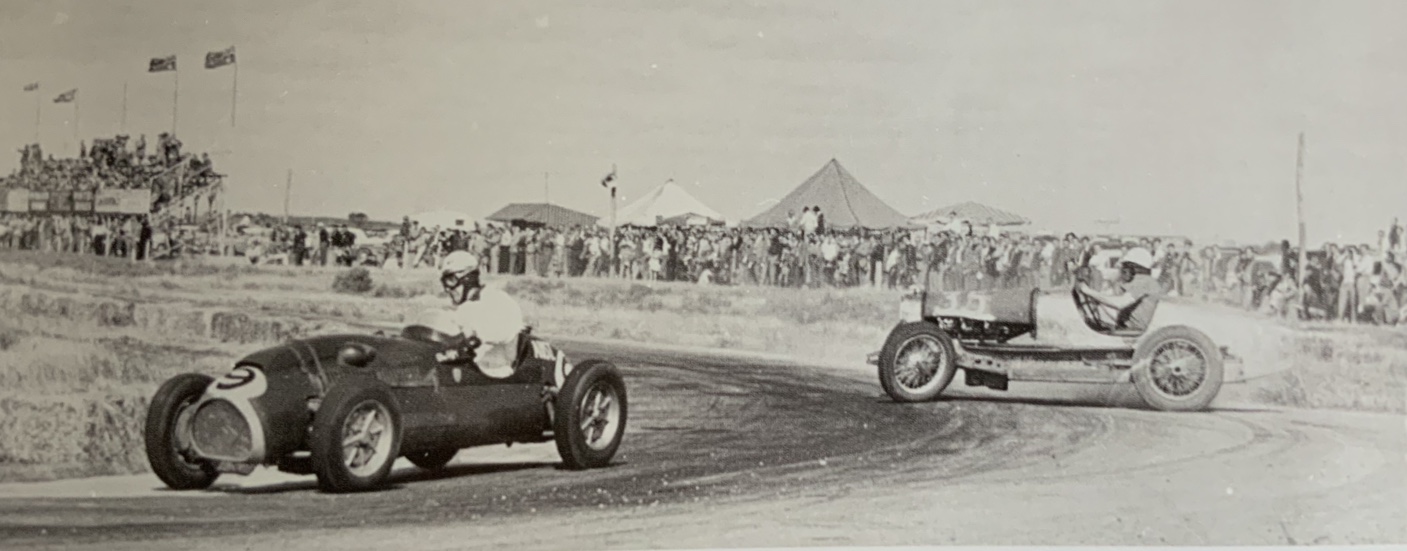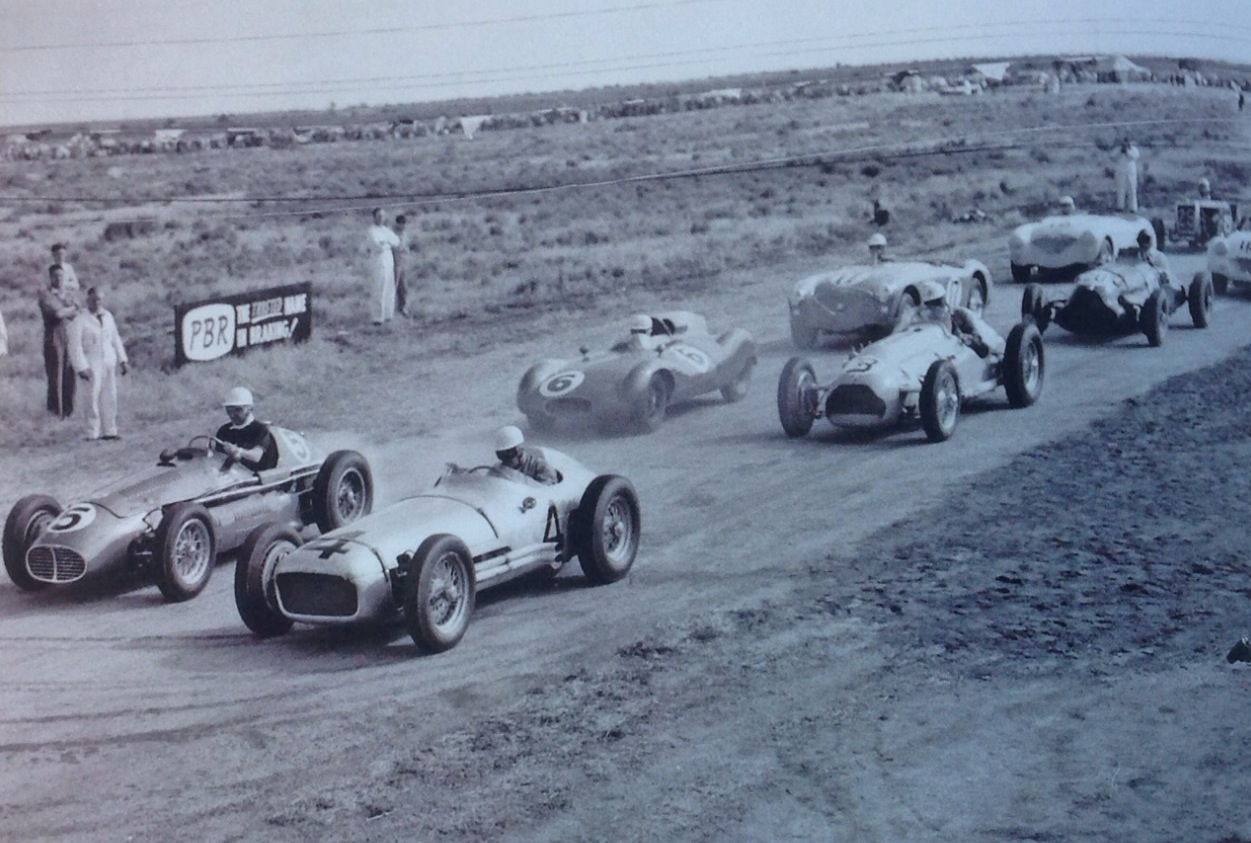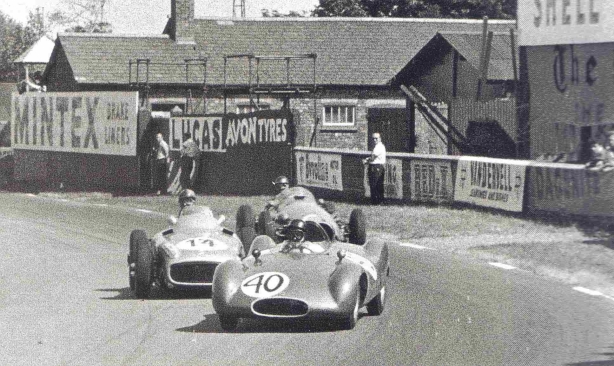
Baptism at Aintree – Karl Kling’s Mercedes W196 & Roberto Mieres’ Maserati 250F push Jack at his 1st World Championship F1 event. Cooper T40 Bristol. 1955 British GP. (Jack Brabham Story)
Sixty years ago today, Jack Brabham made his Formula 1 GP debut at Aintree, but first he had to build the car…
The first half of 1955 was full of many goings on for Jack Brabham. With encouragement from the UK RAC motor sporting administrator, Dean Delamont, Jack was convinced to head over to the UK for some motor racing. Little did anyone know the success this would bring – although it was hardly immediate.
It the pages of the February 1955 ‘Australian Motor Sports’ there’s a brief piece on Jack and his trip to the Continent and it rumours that he had ordered a Cooper-Alta and might have a trial drive with Mercedes Benz. To finance such a trip he had to sell his highly developed & successful ‘RedeX Special’ – aka Cooper-Bristol. Stan Jones, having wrecked his Maybach II at the 1954 Australian GP purchased it. Just prior to selling though, Jack had his last race in the ‘RedeX’ at the January 31, 1955 Gnoo Blas meeting. This was a big meeting for the country NSW circuit with international drivers’ Peter Whitehead and Prince Bira running Ferrari & Maserati respectively. For Jack another part of financing the UK journey also meant selling his lathe and some other equipment – all to his later lament.

The unloved ex-Whitehead Cooper-Alta at Ibsley. (Jack Brabham Story)
Flying to the UK, meant initially leaving his wife, Betty and young son, Geoffrey in Australia. Soon after arriving Jack took delivery of the ex Peter Whitehead Cooper-Alta. In fact he originally set up camp at Whitehead’s Chalfont St Peter’s race garage before a slightly later move to Bob Chase’s RJC Motors operation at Saltdean. His racing activities in the UK, began with the Cooper-Alta at the April 11, 1955 Goodwood Easter Monday meeting. The same meeting Cooper Cars debuted their petite 1100cc Coventry-Climax T39 ‘bobtail’ sports car. Their first foray into what would become a successful ‘Climax’ engine relationship.

Brabham’s brand new, self built Cooper T40 Bristol, Aintree, British GP 1955. Car and driver victorious in the 1955 Australian GP, Port Wakefield later in the year. (unattributed)
History tells us that Jack Brabham never said much, he let his ability do the talking, whether by his driving or engineering skills. But he knew how to get what he wanted. Neither Charles, nor John Cooper ever officially interviewed Jack for a job at Cooper’s Surbiton works. He just hung around often enough until he was one of them.
Despite its Cooper heritage, Jack’s lack of enthusiasm remained for the Cooper-Alta. Even after an engine blow-up at the April 30 Ibsley meeting on the old RAF base, saw him convert it to Bristol power. Meaning he was never going to be satisfied continuing to race that car.
So having gained his new friendship with the likeable John Cooper, Jack was allowed use of Cooper’s Surbiton facilities to knock together what would be his own interpretation of Cooper’s new T39 ‘bobtail’ – shoehorning a big engine into a small sports car. One could even say this was an early incarnation of what would evolve into the Can Am style cars of the mid 60s and onwards.

The bare bones of the Cooper T40 Bristol under construction. Tubular ‘curvy in the usual Cooper way’ chassis frame. Front and rear suspension upper transverse leaf spring and lower wishbones with Arnstrong shocks, drum brakes, 2 litre Bristol 6 cylinder engine.(Jack Brabham Story)
Part of Jack building his ‘streamliner’ F1 car, involved adding 50mm to the chassis’ wheelbase to accommodate the familiar to him, 2 litre Bristol 6 cylinder lump – in place of the 1100 Climax 4. Both built with the engine behind the driver. Worth noting is that in some official entry lists the car is claimed to have a 2.2 litre Bristol. Apparently that was the intent, but not reality. It was also built devoid of lights and anything that would add unwarranted weight.

The Bristol 2 litre 6 cylinder in the rear of the T40. (Jack Brabham Story)
This project later tagged as T40 in the Cooper genealogy stakes – with 2 constructed. One Jack would use himself, this car was allocated chassis number CB/1/55 and another that Bob Chase’s RJC Motors would briefly run for Mike Keen. I say briefly, because unfortunately a crash at the August 20, 1955 Goodwood 9 hour took Mike’s life and the ever present problem of fire destroyed the car.
Jack Brabham’s UK presence hadn’t gone unnoticed by the UK specialist motoring press, gaining a few comments in race reports. Autosport magazine even showed off the incomplete T40 in their pages the day before its first race. Admittedly the photo would have been taken sometime before that, but it was a brand new car when it hit the circuit – with no test time.

Autosport 15 July 1955 Cooper/Brabham announcement.
Liverpool’s Aintree circuit was the venue for the running of the July 16, 1955 British GP meeting. This meeting became Jack’s F1 debut race. The programme even mentions ‘The Cooper Grand Prix entry is a prototype of a full team to be built to race in 1956.’ A slightly premature comment as it turned out and the only F1 Grand Prix the T40 would take part. The car’s haste to complete meant new car sorting was lacking and a rear of grid start. Having liberated the Harley Davidson clutch setup from his Australian ‘RedeX’ C-B before sale, with some irony it was this part that let Jack down at Aintree making for an early retirement at 30 of the intended 90 laps the outcome. The dominant Mercedes Benz W196 team that included Juan Manuel Fangio, Karl Kling and Stirling Moss, saw Stirling taking race honours.

Jack Brabham’s Cooper T40 Bristol from Ken Wharton Vanwall VW55 equal 9th, with victor Stirling Moss about to round them up in his Mercedes W196. (Bill Henderson)
Despite the niggling start Jack had more faith in the T40 than the Cooper-Alta. What followed over the ensuing month were national events at July 30 Crystal Palace & August 1 Brands Hatch with further retirements at both. Then crossing over the Scottish border his luck with the T40 began to change at the August 6 Charterhall meeting. Finally two 4th placed finishes in his Heat and Final. Continuing into the following week’s damp August 13 Snetterton. At that meeting Jack was able to mix it amongst some of the motor racing luminaries. Such as Harry Schell & Ken Wharton in Vanwall’s, Stirling Moss in his privately entered Maserati 250F and Roy Salvadori 250F. That being the finishing order for Snetterton’s RedeX Trophy race with Jack slotting in between Stirling and Roy for another 4th place. Had he not spun during his tussle with Moss it may well have been a 3rd place greeting him. This race alone was enough to convince Jack he would return to the UK in 1956 as he was about to send the Cooper T40 home to Australia. Jack and Betty then set to return to Sydney in late September to catch up with their son and more motor racing.
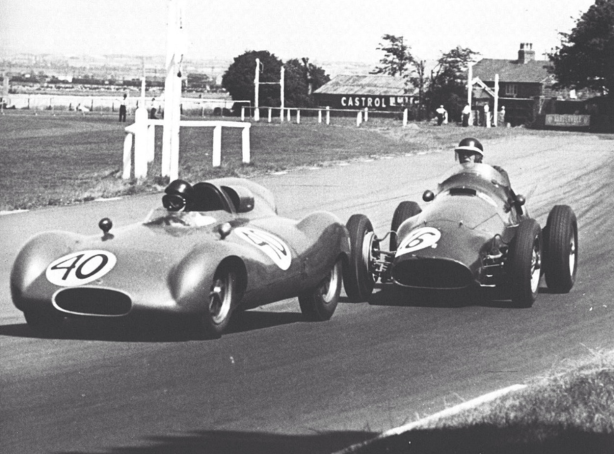
Jacks thoroughly modern mid engined, ‘central seat sports derived F1 car’ ahead of the over the hill Ferrari 625 of Mike Hawthorn, monstering the little Cooper. MH finished equal 6th in the race with Fazz teammate Eugenio Castellotti. Things got better for Ferrari, the Lancia D50 ‘gifts’ were not too far away! (unattributed)

The year of 1955 was also a period whereby other Aussies had made the trip to England for a racing holiday. Orders had been placed with Aston Martin for 3 of their DB3S racing sports cars. The ‘Kangaroo Stable’ as it was so named with members being Tony Gaze, David McKay, Les Cosh, Dick Cobden, Tom Sulman & Jack Brabham. Circumstances played against them though. Late delivery of the cars didn’t help, but it was the June 11-12, 1955 running of Le Mans that put the skids on racing soon afterwards with a number of events cancelled as a result to the Pierre Levegh Mercedes going into the crowd at Le Mans.

‘Kangaroo Stable’ Aston Martin DB3S at the Hyeres 12 Hour, France 29 May 1955. L>R Gaze, McKay, Brabham, Cosh and Cobden standing near the post. Only Tom Sulman is missing from the shot. Race won by Canonica/Munaron Ferrari 750 Monza, then came the Kangaroo Stable trio; Gaze/McKay 2nd, Cosh/Cobden 3rd and Sulman/Brabham 4th. (David McKay ‘Behind The Wheel’)
Jack Brabham was present at the famous French road course that year, but as a reserve driver for the Bristol team. He got to qualify, but never received the call up to put his helmet on for the race. That may well have been one of several omens Jack was granted in 1955 and over his outstanding career.
Cooper Cars Ltd also had a presence at Le Mans with the John Brown/Edgar Wadsworth Cooper T39 1100 and the Whitehead Brothers Cooper-Jaguar that year, but it was the infancy of Jack and John’s friendship, hence no involvement with the Surbiton marque’s effort
Another instance of Brabham luck was just before he headed for home. September 17 was the Dundrod RAC Tourist Trophy meeting in Ireland, with Jack there to share the Michael O’Shea owned Cooper T39 with London driver, Jim Mayers. An inexperienced French driver, Vicomte Henri de Barry created annoyance for several drivers as he baulked their progress, with those drivers’ having to take risks to get past to further their race on the testing Irish road course. Unfortunately the situation ended as badly as it could with a fiery crash at Deer’s Leap involving several cars. Jim was one of 2 drivers to die at that crash scene – the Cooper scattered to oblivion. This event would also claim another driver, elsewhere around the course. Although not knowing otherwise, Dean Delamont had sought out Betty Brabham, thinking it was Jack involved in the main crash – only to find him in the pit. Jim and Jack had flipped a coin to decide who did the first stint. We know who won…
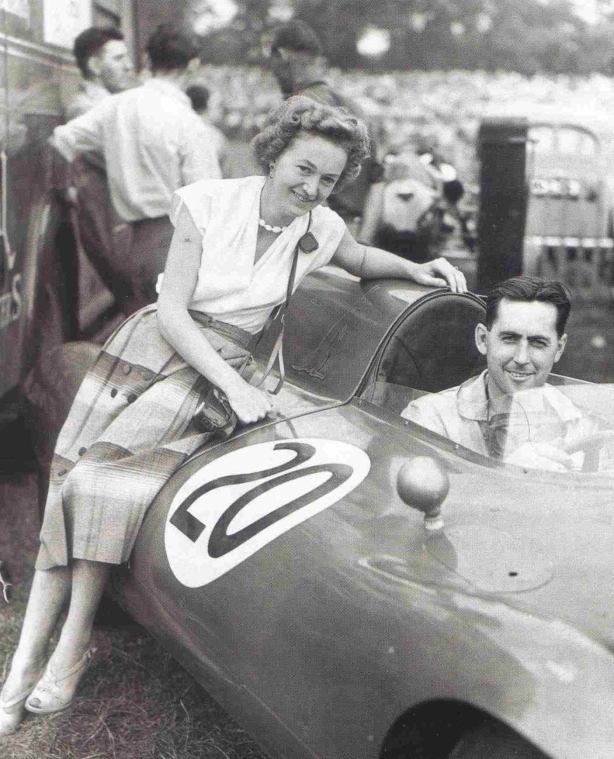
Together in the UK, Betty Brabham followed Jack mid-year. While their son, Geoffrey stayed with his grandparents in Sydney. Cooper T40 Bristol. (Jack Brabham Story)
So as can be seen there were a few familiar names that helped establish Jack Brabham in those early days in the UK – Whitehead, Chase, Cooper & Delamont. The Bristol marque also played its part with their engine and the Le Mans reserve driver gig. Through them, Jack Brabham, Jim Mayers & Mike Keen are also entwined with their 1955 Le Mans Bristol team involvement. Taking out 7th (Mayers), 8th (Keen) & 9th places behind Jaguar’s Mike Hawthorn, Ivor Bueb winning entry. It was all a taste of the next 15 years Jack would encounter in the highest levels of motor racing, including building more racing cars.
Etcetera…

Jack shipped the Cooper Bristol home to Australia at the end of 1955, and in the saltbush country of the new Port Wakefield circuit, 100Km from Adelaide, won the 1955 Australian Grand Prix on 10 October. A lucky win from Reg Hunt’s ailing Maserati A6GCM and Doug Whiteford’s Talbot-Lago T26C. The first mid-engined AGP win. (unattributed)
Bibliography and Photo Credits…
‘The Jack Brabham Story’ Jack Brabham and Doug Nye, ‘Behind The Wheel’ David McKay, Bill Henderson
Finito…












